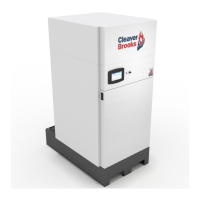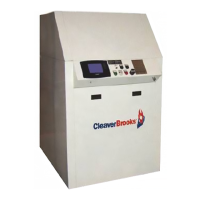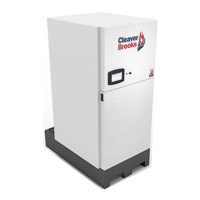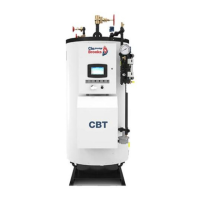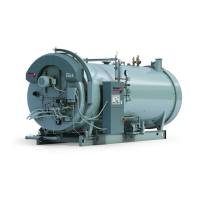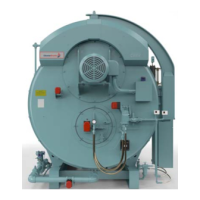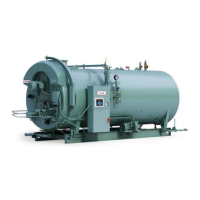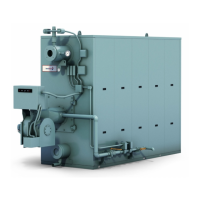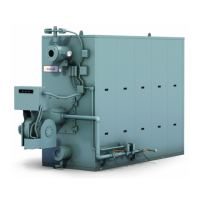750-265 10
3. Connect the ground wire of the main power connector,
the CH pump, the DHW pump (if present) and the igni-
tion wire to the central ground terminal.
Electrical Connections
1. Refer to Table 4 for terminal contact ratings.
2. Use 18 AWG or larger wires.
3. Wire according to specifications, following all local ordi-
nances and requirements.
Device Power Supply, 24Vac
1. 24Vac Supply to connector J8-1.
2. 24Vac Return to connector J8-2.
3. Ground to central ground terminal, not to Ground on
J4-12.
Limit String and Annunciator inputs and Safety Load
Outputs
1. Wiring to connectors J4, J5, J6 and J7.
2. Line Voltage (120Vac) or Low Voltage (24Vac) by model
number.
Dry Contacts available for:
1. Pump A: Connector J4-6 & 7.
2. Pump B: Connector J4-4 & 5.
3. Pump C: Connector J4-2 & 3.
4. Blower: Connector J5-6 & 7.
5. Alarm: Connector J6-7 & 8.
Wiring Connectors J2, J8, J9, and J10
Low Voltage Connections
(includes NTC Sensors, PWM Combustion Blower
Motor, Remote and TOD reset, current and voltage
inputs)
1. Wire according to specifications, following all local ordi-
nances and requirements.
2. Do not bundle the low voltage wires with the ignition
cable, 120 Vac wires, CH Pump or DHW Pump.
3. Bundle the wires for the fan and join them with the other
24V low-voltage wires.
4. Bundle the wires for the NTC sensors and the PWM
pump control separately.
High Voltage Cable
1. Always use a grommet when placing the high voltage
cable through a sheet metal panel.
2. Never join the high voltage cable with other wires.
• Be sure that there is a good electrical return path between
the CB Falcon and sparking electrode (ground connection).
• A short ignition wire normally leads to lower levels of
radiated electromagnetic fields.
• Use a Spark cable (32004766 or R1298020) or equivalent.
• Heat-resistant up to 248°F (120°C).
• Isolation voltage up to 25 kV DC.
Note that the high voltage ignition and the high voltage ignition
lead and the return path of the current that flows during
sparking is an important cause of electromagnetic
interference.
A ground return wire is required in the appliance to reduce the
high frequency components of the actual return current.
The following contradictory arguments apply:
• A short loop in the ignition wire and the return wire
minimizes the electromagnetic field. (This means an
ignition return wire close to the ignition lead or, if such a
wire is not present, laying the ignition wire close to earth
metal.)
• A return path close to the high voltage wire increases the
total capacitance of the load connected to the high voltage
transformer and will therefore reduce the maximum voltage
and make it more difficult to have sparking at the spark
plug.
• A return path close to the ignition lead or earth metal
increases the changes of flash-over though the isolation of
the cable.
Communications: Connector J3
1. Connect the S7910A Keyboard Display only to the Envi-
raCOM port, connectors J3-1, J3-2, J3-3. Do not con-
nect the 833-3577 display to these connectors.
2. Connect the 833-3577 Display to either J3 Local Modbus
port, connectors a, b, c or J3 Global ModBus port a, b,
c.
Flame Signal: Connector J1
1. Flame Rod: Single Element
a. Connect the Flame rod for both ignition spark and
flame sense to the ignition transformer terminal.
b. Connect the Flame rod ground to connector J1-3.
2. Flame Rod: Dual Element (separate elements for igni-
tion spark and flame sense)
a. Connect the Flame rod sense lead to connector J1-2.
b. Connect the Flame rod ground to connector J1-3.
c. Do not route the Flame rod sense lead wire or
ground wire near the ignition spark high-voltage
cable or other line voltage wiring.
UV Flame Detection
1. Connect the UV Flame detector sense lead (blue wire)
to connector J1-4.
2. Connect the UV Flame detector ground lead (white
wire) to connector J1-6.
3. Do not route the UV Flame detector wiring near the igni-
tion spark high-voltage cable or other line voltage wir-
ing.
Final Wiring Check
1. Check the power supply circuit. The voltage and fre-
quency tolerance must match those of the CB Falcon. A
separate power supply circuit may be required for the
Falcon. Add the required disconnect means and over-
load protection.
2. Check all wiring circuits.
3. Install all electrical connectors.
4. Restore power to the panel.
The CB Falcon can be removed and replaced in the field without
requiring re-wiring.
The lengths of the wires and electrical ratings for each
terminal are specified in Table 4 on page 13.
